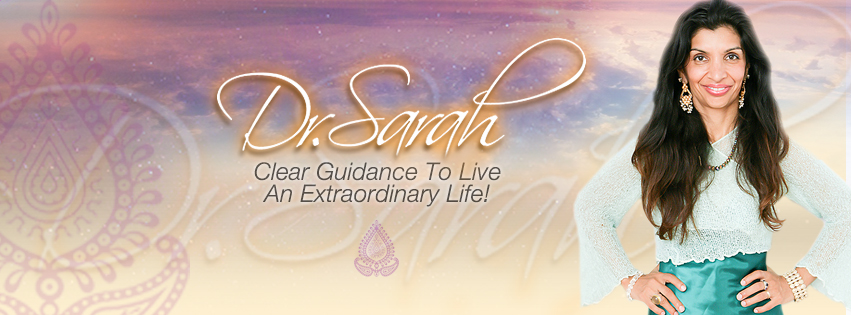Katie Ness in her article Sacral Chakra shares: Here’s Everything You Need to Know About Your Second Chakra
“The truest expression of a people is in its dance and in its music. Bodies never lie.”Agnes de MilleAmerican dancer and choreographer
Here are the main characteristics of the Sacral Chakra:
The sacral chakra resonates with our need for relationships and our need to control or create the dynamics of our physical world. The second chakra shifts from obeying tribal, family authority, and allows us to discover satisfying relationships and interests of our own.
But if the first chakra is already out of balance with lack of root support from your first tribe, how are you supposed to learn how to form harmonious friendships, relationships and healthy physical interests later in life?
The Sacral Chakra Houses Creativity, Relationships, and Sexuality
Being creative in nature, the sacral chakra’s main focus is allowing the individual to discover what they enjoy, to form hobbies, create loving and exciting relationships, and even creativity in lovemaking and sexual eroticism.
The second chakra is centered on personal identity or personal play in the external world and how it responds to the seductive forces of the physical world. Therefore, if the second chakra is unbalanced, it can lead to addictions of drugs, sex, gambling and money.
The Svadhisthana is the foundation of a healthy ego that allows us to interact with the world without selling ourselves short or pretending to be someone we are not. A person with a strong second chakra can survive financially and physically on his or her own and bond with others to form harmonious friendships. A balanced second chakra has the ability to take risks and have the resilience to recover when things go wrong.
How the Second Chakra Relates to Sex
Sexually, this is the pleasure chakra that essentially ‘turns us on’ and is deeply connected to our partnerships with others. This chakra also correlates to physical things that we find pleasure in such as painting, fishing or writing erotic poetry – whatever floats your boat!
Sexual eroticism is a form of physical and emotional freedom as well as spiritual liberation because it is about being in the moment so we can let go of our fears and boundaries to enjoy the bountiful happiness of the human experience.
What the Sacral Chakra Teaches Us
This chakra is all about having the power to realize and utilize your talent to express the life you want to lead. A sacral chakra in distress can form abusive, controlling relationships, and cause bullying in the workplace, fear of abandonment, and loss of financial and creative power.
The lesson the sacral chakra teaches us is that every relationship we create – from the casual to the most intimate – has a purpose, no matter how painful, to help us become more consciously aware of our karma and ourselves. Some relationships are necessarily difficult because it makes us learn about our own limitations and ourselves.
Through this lesson, we remember that nobody is perfect – all human beings are beautifully flawed. So the next time that rude colleague is mean to you, try to empathize with them. They might be having a rough day or perhaps had a turbulent childhood that has caused a number of complexes.
The Power of the Sacral Chakra
Symbolically and literally, the sacral chakra is the birth canal. We have the capacity to birth a life we want, to start that project we’ve wanted to, a relationship with the cute guy in the coffee shop, or a friendship with a fellow yogi in class.
It is having that personal power of choice to make the move. It is the sensation of being physically alive and creating the life you desire.
Balance Your Sacral Chakra with these Yoga Poses By Yoga Bear
Having read previously about the Sacral Chakra, we have learned that, a balanced sacral chakra can bring with it sense of creativity and connection to other people.
Here are some poses that can either stimulate the chakra to increase energy or release excess energy. Hold each pose for five, slow deep breaths.
Located in the lower abdomen, below the navel, this chakra relates to our sense of creativity and connection to other people.
An imbalance in this chakra can result in emotional instability, lack of energy and motivation, low self esteem and dependency on others.
This can physically manifest in urinary infections, lower back pain, and irregular menstrual cycles among others.
A balanced sacral chakra will have you feeling full of energy, confident and inspired to enjoy each new experience life brings. The sacral chakra is represented by the colour orange.
Goddess Pose (Utkata Konasana)
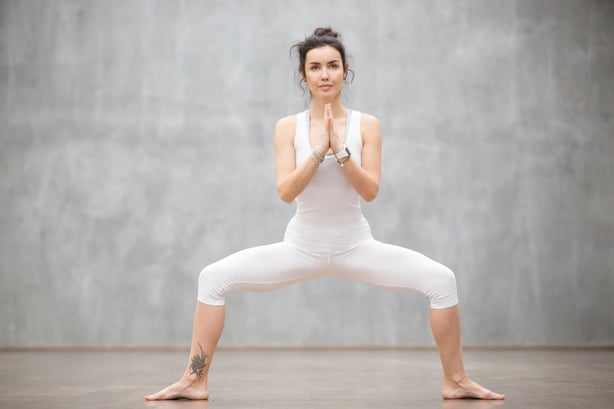
- Stand with your feet wide apart and your feet turned outwards.
- Bend your knees deeply working towards having your thighs parallel to the floor (remember that’s a ‘goal’ not a ‘target’ – work within your ability).
- Align your knees over the centre of the feet. Ensure that the shoulders are stacked above the hips.
- Lengthen the tailbone downwards while lifting through the crown of the head.
- Bring the palms together in front of the heart (Anjali Mudra).
Reverse Warrior Pose (Viparita Virabhadrasana)
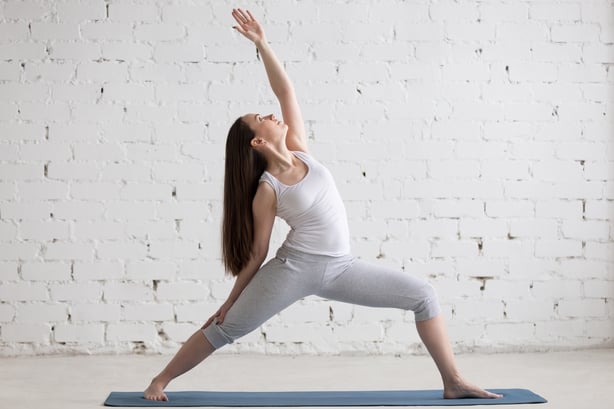
- From Goddess Pose, turn your hips to the right as you spin your back heel outwards and place it onto the mat with the toes turned in a little.
- If you find you’re a little off balance, you can bring the right foot out closer to the long edge of the mat. Otherwise align the heel of the right foot to the arch of the left foot.
- Extend your arms outwards at shoulder level then rotate the palm of the right hand upwards as you begin to arch up and back, sliding the left hand down the back leg.
- Soften in the upper body while remaining strong in the legs.
- Stay here for a couple of breaths then repeat on the other side.
Wide-Legged Forward Bend C (Prasarita Padottanasana C)
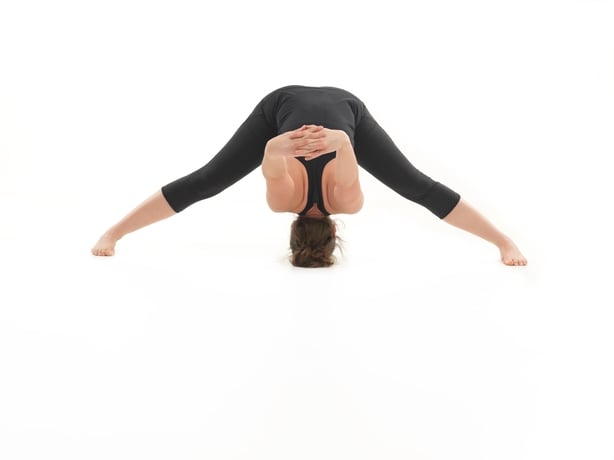
- Stand with your feet wide apart, legs straight and your toes pointing forwards.
- Interlace your fingers behind your back and rest them on your sacrum (that piece of bone at the base of the spine between the hip bones).
- Roll the heads of the shoulders back as you draw the shoulders blades down the back and begin to extend the arms downwards.
- Begin to hinge forwards from the hips to fold forward, lengthening the crown of the head towards the floor.
- Bring the weight forward a little, aligning hips over heels. It feels like you might topple over a little but let that feeling go and trust that your body know what to do.
- Stay here for a couple of breaths before lengthening through the crown of the head to lift up and out of the pose.
Seated Forward Bend (Paschimottanasana)
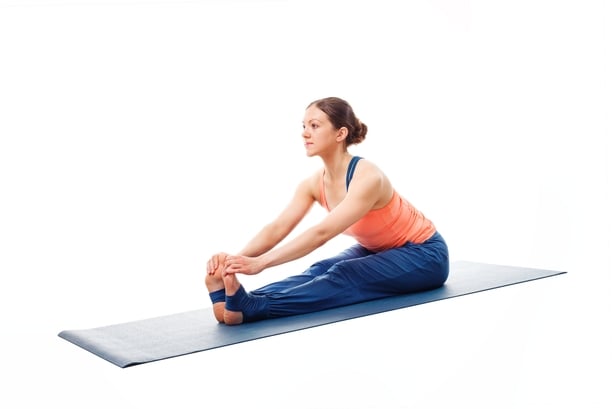
- Sit either on your mat or on a rolled-up blanket or foam block to elevate the pelvis slightly and prevent rounding in the lower back.
- Extend the legs long and gently rock from side to side to discover your ‘sit bones’ and ground them into the mat/block.
- Press gently through the heels to keep the feet flexed and the toes soft.
- Raise arms above head and lift up through the fingertips, palms facing each other.
- Inhale and as you exhale begin to hinge forwards from the hips, leading with the heart, keeping length in the spine and avoiding a rounding in the lower back.
- Place your hands on the mat beside your calves and inhale to lengthen through the crown of the head, extending the heart forward, exhale to release and fold a little deeper.
- Stay here for a couple of breaths maybe repeating the inhale to lift, exhale to fold movement a couple of times and feel into the gentle stretch across the back of the legs.
Reclined Bound Angle Pose (Supta Baddha Konasana)
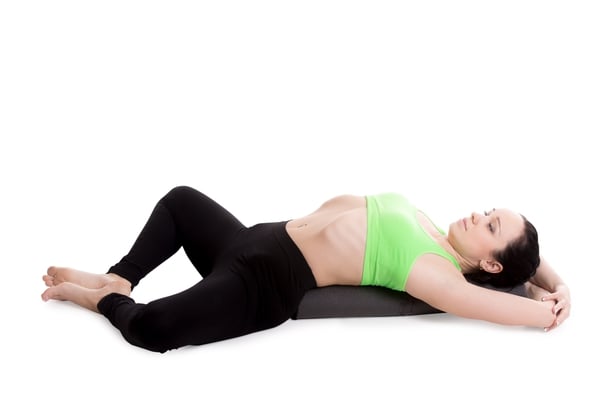
- Lie on your mat and bend your knees, bringing the soles of the feet together and letting the knees release out to the sides towards the floor. If you wish, you can place a block underneath each knee for support.
- Place your palms on your belly, letting your elbows rest on the floor. Inhale and with each exhalation, allow your body to get a little heavier.
- A nice way to practice these poses is to bring with it an intention of spaciousness within the hips and pelvic area.
- Draw on your own creative energy and belief in your abilities.
- Approach the day with a sense of openness to yourself, others, new experiences and joy.
